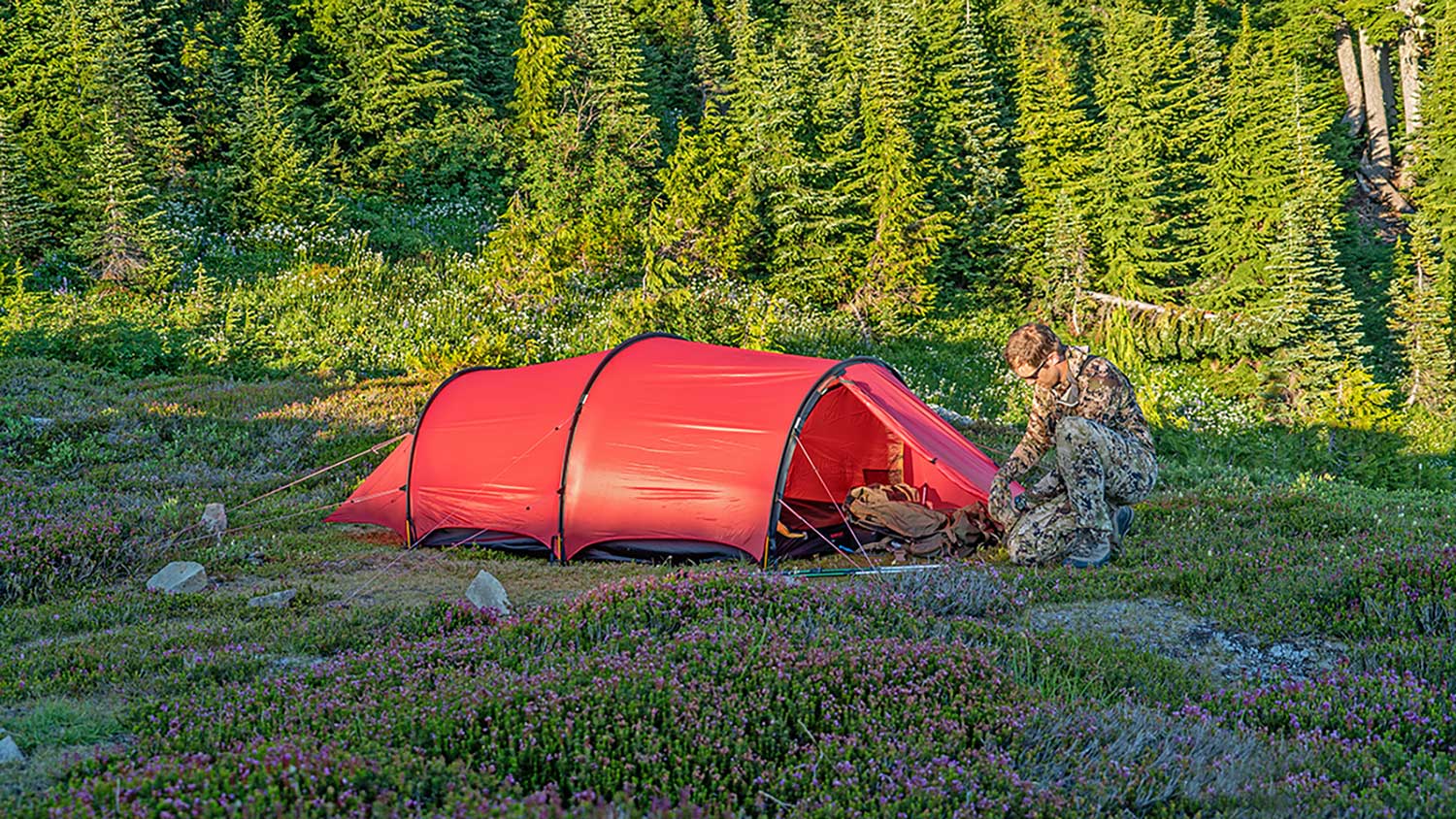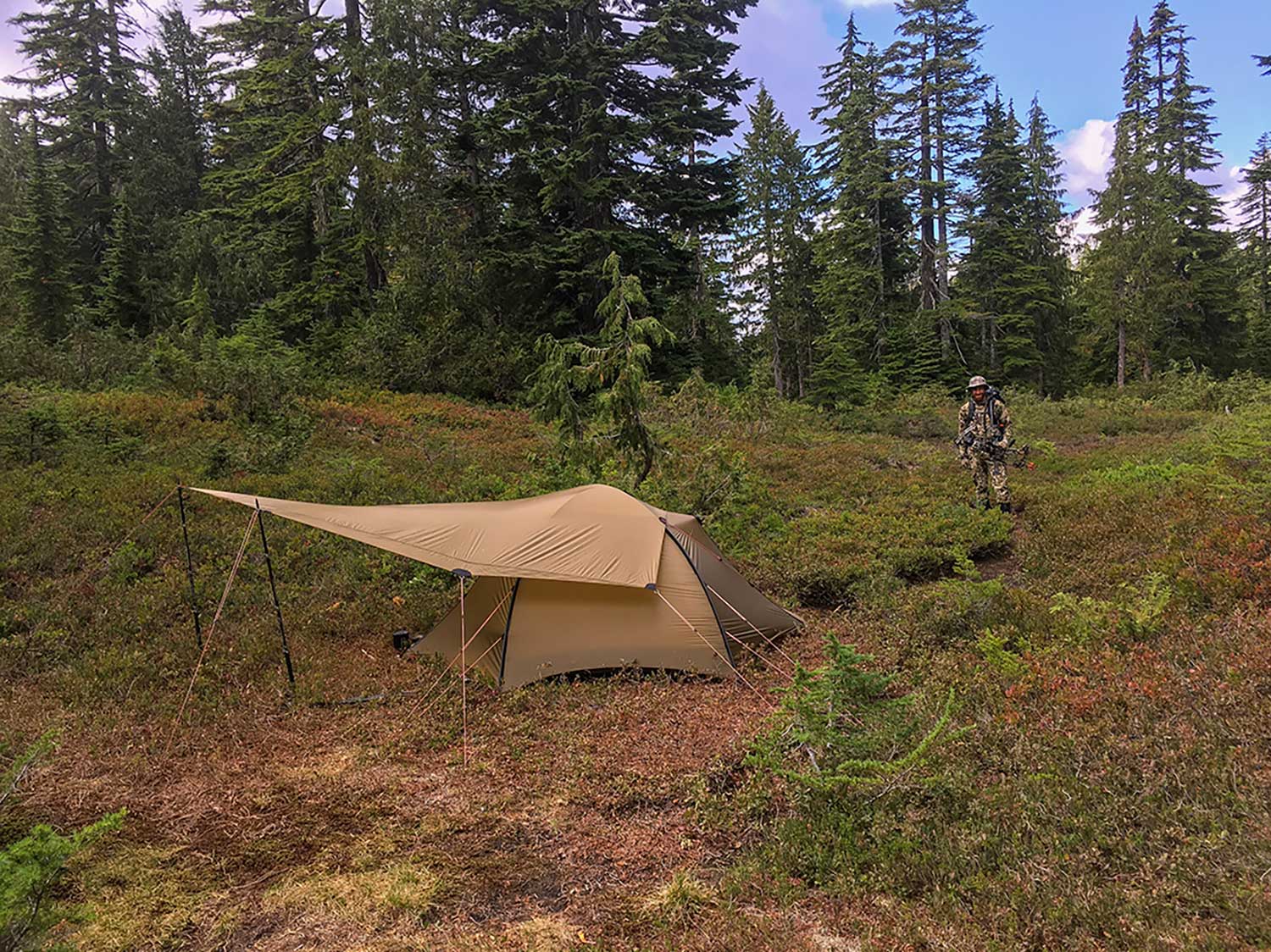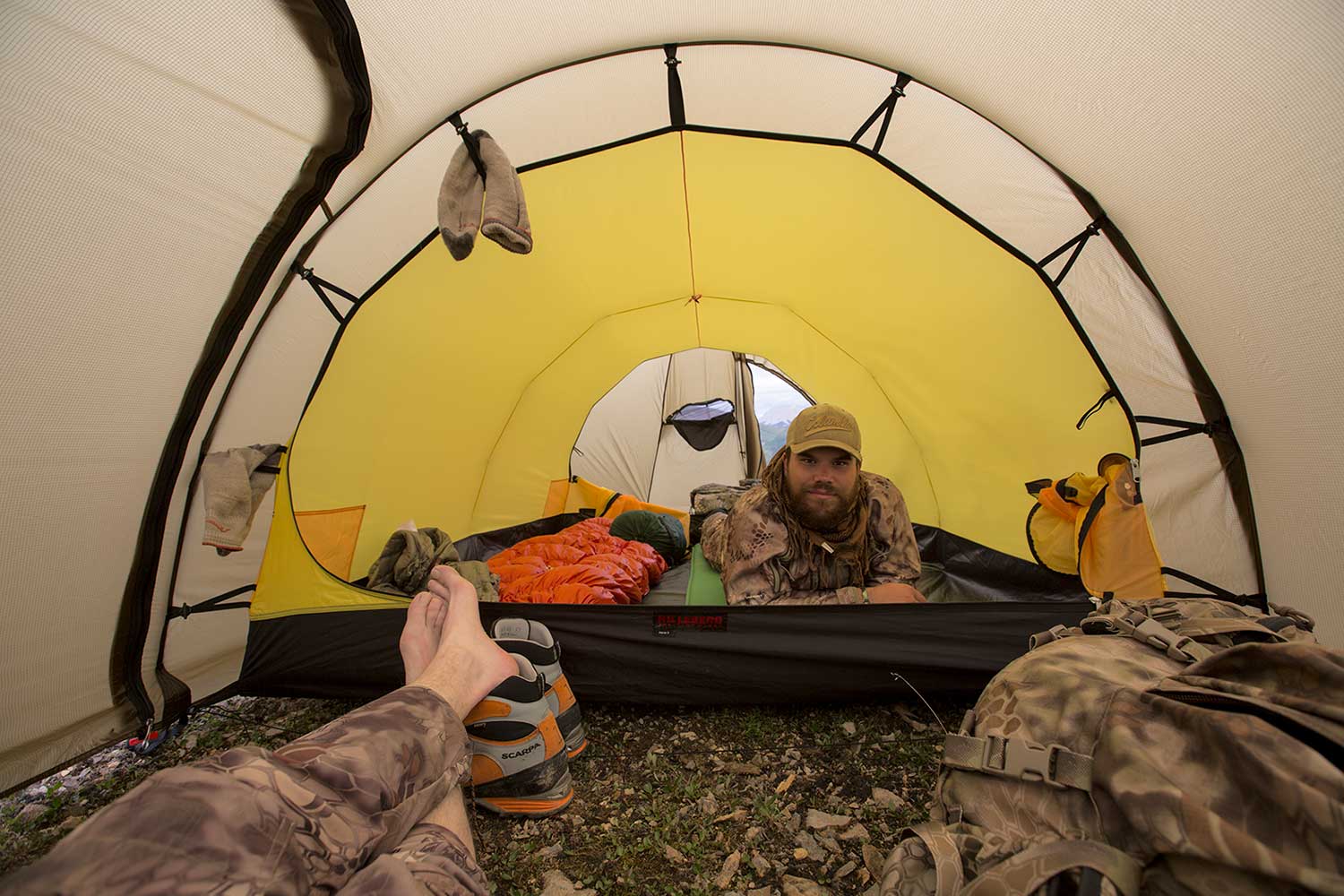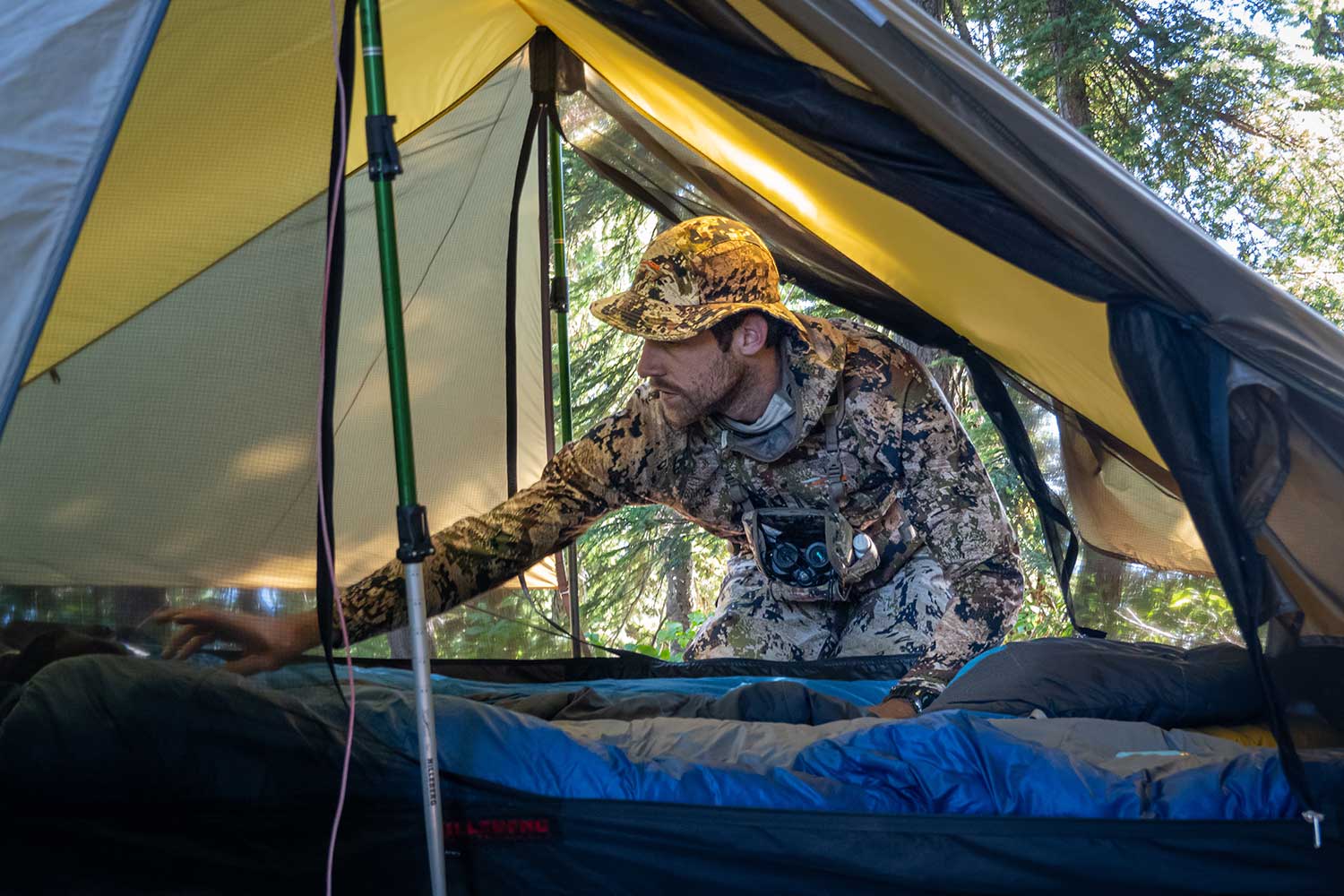There is always debate over the “best gear” for Elk hunting, but “Elk hunting” isn’t just one thing. Depending on terrain, time of season, and, of course, weapon, each Elk hunt has its own character. Add to that the style of hunt – single day or multi-day, access by foot or horseback (or motorized vehicle), lodge-based or self-supported, and so on – and choosing the right gear could get complicated.
If, however, your idea of Elk hunting is a multi-day, DIY affair, probably on public lands, and accessed mostly on foot, gear choices become crystal clear. You need a comfortably sturdy pair of boots and an equally comfortable and sturdy pack, and the right tent. And if you do some research into what that “right tent” might be, you’ll frequently come across the brand Hilleberg.
Hilleberg does not make an “Elk hunting tent,” nor even any kind of specific “hunting tent.” Nor do they make tents dedicated directly for backpacking, or climbing, or paddling or any other specific activity. What they do make – and have made for 50 years – are utterly reliable, strong and lightweight tents (and shelters) of the highest quality for adventurous backcountry use in any season, any weather, any terrain, anywhere. Meaning that regardless of where or when you do your Elk hunting (or any other adventure), Hilleberg has a tent that can contribute greatly to your getting the most out of the experience.
“I was looking for the best tent for all my needs, hunting and otherwise,” says Jon Dykes, Hilleberg’s Hunting Manager. “In all my research, Hilleberg kept coming up, and I had some long conversations with one of the Hilleberg hunting retailers and decided on the Staika, a Black Label dome tent. I bought it, like many do, without having seen it in person, and I was immediately happy with it.” Jon grew up hunting, fishing and being very active in the outdoors, and through his work filming hunts professionally, as well as on his own, has hunted throughout North America. “I was so impressed with my Staika,” says Jon, “that when I saw a job opening at Hilleberg, I applied immediately, and I’m now the in-house videographer and Hunting Manager.”

Hilleberg was founded in Sweden in 1971 and from the beginning has produced function-first tents made from the best materials available. They constantly and continuously do real world testing, and their tents have become the first choice of explorers, adventurers and military units – not to mention sheep hunting guides and mountain hunters. They have their own manufacturing facilities in Europe. They pioneered linked inner and outer tent construction, meaning that the entire tent goes up all at once and so keeps your inner tent dry in all weather, construction that is still a hallmark of every Hilleberg tent.
They were also the first to use silicone-coated fabrics in tents, which they adopted in 1975, and which they have developed into their proprietary Kerlon family of fabrics, members of which are found in every Hilleberg tent. Kerlon fabrics’ defining trait is their tear strength, an essential piece of Hilleberg tents’ reputation.
“Tear strength is a standard materials test,” explains Jon. “In the ISO test we use, it measures the resistance to tearing from an existing cut and is typically expressed in kilograms. In real-world tent terms, that means that if you accidentally get a hole in your tent – from accidentally poking it with a broadhead, stepping on it with your crampons, catching it with your trekking pole or whatever – and the wind starts blowing, if you don’t have high tear strength, that hole will become a large rip that will likely mean you have to abandon your trip. On top of that, since UV weakens all fabrics, if you start with a higher tear strength in your tent, then it will simply last longer. At Hilleberg, we believe deeply that stronger is better, and that a higher tear strength offers better safety and security for you in the backcountry, as well as greater value in your tent.”
Hilleberg tents are known for their durability and a vital part of that is the high tear strength of their outer tent fabrics. A higher tear strength offers better safety and security on backcountry hunts in rough terrain and on long-term trips. In this video, Petra Hilleberg brings in a really strong guy from a nearby gym to demonstrate just how tough Hilleberg’s propriety Kerlon fabric is.
Many, if not most, tent fabrics on the market, even so-called “expedition ready” ones, have tear strengths in the 1- to 3 kg range. Hilleberg’s lightest fabric, Kerlon 1000, rates at 8 kg, while their strongest, Kerlon 2500 (found in some of their large group tents) has a 25 kg tear strength.
Another aspect of Hilleberg’s belief in “stronger is better” is defining their tents’ capability precisely. Rather than talking about “4-season” models, which most people equate with winter tents, Hilleberg makes “all-season” ones, tents that are built to work equally well winter, spring, fall and summer. Similarly, they avoid the term “3-season,” preferring to call the models they build for warmer conditions “snow-free adventure” tents, since spring, summer and fall in, say, northern BC are very different than in New Mexico. “We have very definite ‘rules’ for what makes an all-season tent,” says Jon. “These models have outer tents that go completely to the ground for maximum weather protection, all mesh areas can be covered with adjustable fabric panels, and there are fully adjustable vents, high up, for the greatest options in all weather conditions. Similarly,” he continues, “in snow-free adventure models the outer tents may not go fully to the ground, which offers the greater ventilation often needed in warmer weather settings while still providing full weather protection; the mesh areas of the inner tent are larger; and there are no fabric coverings over them.”
Every Hilleberg tent shares the same basic “tech”: very strong outer tent fabrics, DAC aluminum poles, attached proprietary (and very strong) guy lines, very high hydrostatic head floors, and robust zippers. They distinguish among their over 40 models by categorizing their tents into four “Labels,” Black, Red, Yellow and Blue. Black and Red Label models are all-season tents, Yellow Label models are the snow-free adventure tents, while Blue Label models are all-season group tents. Black Label models are the company’s most robust, all-season models built with Kerlon 1800 fabric in the outer tent (18 kg tear strength) and 10 mm aluminum DAC poles, all of which are the same length for the easiest handling. These tents are built to handle any weather in any season anywhere. Red Label tents cede a small amount of absolute strength for lighter weight but are still capable of handling all but the worst conditions year round. They save weight by using Kerlon 1200 in their outer tents (12 kg tear strength), and 9 mm DAC aluminum poles, and often by having poles of differing lengths. Yellow Label models – those made for snow-free adventures – are the lightest in the Hilleberg range, built with the company’s lightest Kerlon fabric, Kerlon 1000. These tents do, however, share the same 9 mm poles found in Red Label models and so offer plenty of strength.

“Most hunters gravitate to the Red and Yellow Label tents,” says Jon. “The Yellow Label tents are very strong and will handle anything outside of the real snow times, and Red Label models will easily get you through even big winter storms. That said, if your hunt is in the ‘not if you get snowed in but when and for how long,’ then the Black Label tents, with their added strength, are the way to go.”
Jon uses similar models across the Labels to illustrate his point: the Black Label Keron (3 or 4 person), Red Label Kaitum (2, 3 or 4 person) and Yellow Label Helags (2 or 3 person). “All of these are two-vestibule tunnel tents that share the same appealing characteristics: maximum interior space, excellent flexibility because of the two entrances, and tremendous space to weight ratios,” he says. “If I were doing a late-season hunt in Alaska or the bigger mountains in BC or Montana, or if I were tying snowstorms to tracking Elk, I’d take a Keron. It might weigh a bit more, but the security in the face of real weather is priceless.” For general, all-around trips or hunts anytime, he’d opt for the Kaitum. “It’s strong enough to handle anything I’d likely encounter, it’s super comfortable, and, if the weather changes from cold to hot – as it can in the mountains – being able to fully roll back both of the Kaitum’s vestibules gives amazing versatility.” On any hunt where snow is only a remote possibility, Jon calls the Yellow Label Helags tunnel tent “hands down one of the best hunting tents there is. I recently did a trip with a buddy of mine where we used a Helags 2. He told me that he was more of a ‘dome tent guy,’ but when he climbed into the Helags his first comment was ‘Whoa! Where did all that room come from.’ I’m 6 ft 6 in, and he’s 6 ft 2, and we were incredibly comfortable.”
Jon also calls out that weight savings can be done by choosing a single vestibule model. “I will almost always go for a two-vestibule tent,” he says, “because they offer the most comfort and flexibility. But you can save weight with single vestibule models and still have plenty of comfort.” Again, he identifies to similar models across the Hilleberg Label system, the Black Label Nammatj (2 and 3 person), the Red Label Nallo (2, 3, and 4 person) and the Yellow Label Anjan (2 and 3 person). “The Nammatj is just as strong as the Keron but weighs less. In many ways, I think the Nammatj tents are our most versatile: strong enough for anything and easily light enough for general use,” says Jon. “The Nallo is a great choice when you do want to keep the weight down but still need all-season capability, like on mid- to late-season hunts in the high country in Washington. For warmer conditions, I love how light and airy the Anjan is, and again, the Anjan 2 makes a super roomy and still very light solo tent.”
Hilleberg is most associated with these tunnel tents, sometimes called “hoop tents,” such as their Keron, Kaitum and Helags models Jon talks about. This construction has arced poles in a parallel arrangement, creating the eponymous shape, and while they do have to be pegged out, they also offer the greatest space to weight ratio. And lest you think tunnel tents aren’t strong enough, Hilleberg Black Label Keron and Nammatj models are the de facto standard choice for polar explorers.

Photo: Aron Snyder
But, as Jon says, some people simply prefer dome-style construction, and Hilleberg has that covered, as well. “To show our dome range, I like to compare three of our tents across the Labels,” says Jon. “The Black Label 2-person Staika, the tent that led me into the Hilleberg world; the Red Label Allak, available in 2- and 3-person versions; and the Yellow Label Rogen.” Just to be clear, Hilleberg uses “dome” to encompass different constructions. A true dome tent is often defined as one where all the poles cross at the same point, but many of Hilleberg’s “domes” have multiple pole-crossing points, a framework that strays into what other companies often call “geodesic” tents. “The Staika is a true dome tent,” says Jon, “and it is incredibly strong. I’ve used it in truly heinous conditions with full confidence, and it is also wonderfully comfortable for more casual, short summer trip use. The Allak shares the Staika’s essential footprint – two vestibules parallel to the sleeping area – and is very comfortable. It also has our ‘hybrid dome’ build, with multiple crossing points, and so is impressively strong while still keeping the weight down. The Rogen, effectively the Yellow Label version of the Staika and the Allak, is, of course, the lightest of the three has the same roomy and comfortable two-vestibule/parallel sleeping area layout. I’ve used the Rogen a lot, and I love how airy it is, both with a partner and as a solo tent.” As with his Keron/Kaitum/Helags comparison, he tags the Black Label Staika as the tent of choice for late season hunts where snow is inevitable and the weather likely to be challenging, and the Allak for all-around, all-season use. The Rogen he favors for warm weather trips, especially in his early and mid-season hunts in the Washington Cascades.
In talking about these tents, Jon is quick to point out that the Staika and Allak are freestanding tents, while the Rogen is technically not. “Many people call dome-construction tents with vestibules that need to be pegged out, like our Rogen, ‘freestanding,’” he explains. “But at Hilleberg, we think that’s misleading, since you can’t really use these tents without the vestibules. Instead, we call these kinds of tents ‘self-supporting,’ since the main body of the tent stands on its own. We reserve ‘freestanding’ for tents like the Staika and Allak, ones that don’t require any pegs for set up (although we always recommend you use pegs), and that have their vestibules integrated into the structure itself.”
To reduce the Hilleberg range of tents to just these six models would be a grave error. Across their more than 40 models are options for any adventure, any hunt, any where. Most of the tunnel models Jon talks about – the Black Label Keron and Nammatj, the Red Label Kaitum and Nallo, and the Yellow Label Anjan – are available in “GT” versions, with an extended vestibule. “The Anjan GT is a great choice for many hunts,” says Jon. “It’s quite light, and its large extended vestibule adds to the space considerably.” Black Label dome tents, the 2-person Tarra, 3-person Saivo, and 4-person Saitaris are excellent base camp tents on hunts in any terrain or season, and the Red Label Jannu, built for the demands of alpine-style big mountain climbing, is a great choice for places like Alaska and northern BC, where the weather can be daunting.
And since hunters often hunt alone – or want to sleep alone at the end of a long day out – solo tents are a key part of Hilleberg’s lineup. “Two of our most popular ‘hunting’ tents are the Niak and the Enan,” says Jon. Both are in the Yellow Label group, and both are among the lightest in the company’s range – and both are very much in demand by Elk hunters. “The Niak is a very light self-supporting dome that’s cozy for two, with a single vestibule,” says Jon. “My wife (who is 5 ft 10 in) and I use it very happily, but where many love it is as a solo tent. If you want as much space as you can get at a really light weight, the Niak is simply outstanding.” Even lighter is the true solo tent Enan, a single pole tunnel-style model. “I’ve used this tent quite a bit, and it is remarkable roomy and wonderfully light,” says Jon. The Enan’s all-season Red Label “brother” the Akto has long been popular with mountain hunters, and it’s plenty strong for Alaska and similar. It’s even been used successfully on both North and South Pole expeditions. For those wanting a solo shelter for the pushing the terrain and weather envelope, there’s the Red Label Soulo and its Black Label counterpart, the Soulo BL. “These are really the strongest solo tents available,” says Jon. “And they’re fully freestanding, so they’re ready for anything, from exposed mountain use in huge storms to rainy, coastal rock slabs to anything in between.”
Another option that sometimes gets overlooked is Hilleberg’s third construction type, the ridge tent, in the form of the Yellow Label Anaris. “It sets up with trekking poles, it’s really light and airy, and it has way more room inside than seems possible. Either for two, or as a mansion for one, the Anaris is one of my favorite warm weather tents. And you can roll back nearly all of the outer tent for fantastic air flow in really hot weather, or make it into a simple yet versatile tarp shelter.”

If you decide that you’re willing to give up comfort for weight savings, Hilleberg has great options for this, as well, with their Shelter category. Mesh Tents, many of which can replace the standard inner tent in complementary models for extra ventilation, other mesh shelters, Tarps, and other items offer a host of options. “I now always carry a Tarp 5, whether on overnights or day trips,” says Jon. “I use it for glassing, a quick shelter, meat protection, a separate kitchen in bear country, a covered ‘porch’ for my tent – it is one of my essentials. And if I want to go full minimalist, either scouting or hunting, I can pair that Tarp with our Mesh Tent 1 for bug protection, or, for wider weather coverage, our Bivanorak, a multi-purpose shelter that can be sleeping bag cover, bivy bag, emergency shelter or even rain gear.”
Hilleberg may not make “hunting tents,” but they do make tents that will work superbly for any hunt. “One of the best things about the Hilleberg range is the depth, along with the company’s quality and deep knowledge,” says Jon. “You can literally create a hunting ‘kit’ to cover pretty much anything you’ll ever do, from Elk hunting anytime, to hot or mild weather early season hunts in the lowlands to gnarly mountain hunts in the alpine.”
